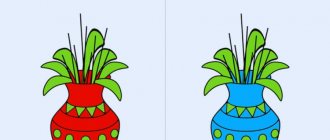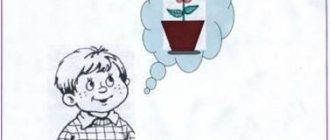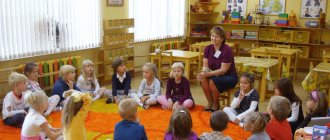Approximate amount of knowledge, educational tasks.
Fix the names of those animals that children were introduced to in the younger group, examining their appearance in more detail, noting their essential features (the body of fish is oval-shaped, covered with shiny scales; there are fins on the back, stomach and tail; fish are large and small, different in Coloration; when swimming, they either rise up or sink down to the bottom of the aquarium). To provide knowledge about the differences in the plumage of birds, the differences in beaks (thin or thick), eye colors (black or light); characteristic features of the legs (thin, toes); emphasize that the body of birds is covered with feathers, that the bird flies, sings (chirps), bathes, and pecks food. When getting acquainted with mammals (animals), note what kind of muzzle they have (round or oval), what color and length of fur, emphasize that it can be soft, fluffy or smooth; what size is the body, what is the shape of the eyes, ears, paws. Provide additional information about habits (animals listen, turn or raise their ears, wash themselves, step silently, hold food in their paws). Continue to cultivate interest and love for animals, caring for them, the desire to observe and care for them.
What animals should be placed in a corner of nature? Pisces (varieties of goldfish, except veiltail and telescope); birds (the same as in the younger group - canary); mammals (the same as in the younger group, at the time of observation).
What children should do to care for animals. Systematically take part in feeding animals with different types of food. Wipe the outer walls of the aquarium, wash the drinkers and feeders. Grow green oats for animal feed.
During their stay in the younger group, the children gained knowledge about some animals and, to the best of their abilities, carried out instructions to care for them. In the middle group, this knowledge becomes a little more complicated. Now children are systematically involved in caring for animals in a corner of nature: the teacher still uses assignments, but their content and nature have become more complicated. The teacher should strive to develop in children certain skills in caring for animals; In this work, children are given somewhat greater independence than in the younger group. The children's responsibilities expand: the teacher teaches them how to wipe the outer walls of the aquarium (with a damp cloth), wash drinking bowls and feeders for animals. Children are given some equipment: basins, brushes, rags. But still, children perform all animal care techniques in the presence of a teacher, under his control. For example, a teacher entrusts two or three children with caring for a bird, while he himself takes a tray out of the cage and cleans it, one child at this time washes the drinking bowl and pours water into it from a watering can, the other washes the feeder and pours food from a can into it. The third child can pour sand onto the tray or give the bird some grass.
The teacher involves some children in caring for the aquarium. He offers one to feed the fish. He asks another to take a damp cloth and wipe the walls of the aquarium. Having finished their work, the children put all the equipment back in place, the teacher checks how they completed the task.
Then the teacher moves on to indoor plants and instructs other children to care for them. Among the children, lovers of plants and animals are gradually emerging; they always eagerly take care of a corner of nature and ask to be given a task. These children are the support of the teacher, but you cannot work with them alone: all pupils must be involved in this kind of assignment in turn, using different techniques to awaken their interest in animals and in caring for them.
Involving children in assignments, the teacher constantly draws their attention to the animals that the children are caring for, to their behavior in the cage, in the aquarium; If children have developed and maintained an interest in animals, they are more willing to respond to the offer to care for their pets.
Card file of observations of indoor plants and labor middle age
Card 29"Introduction to Balsam"
Target:
Continue to teach children to describe plants, while distinguishing the differences and similarities between them and the most characteristic features of their appearance. Teach description according to the plan suggested by the teacher. Strengthen children's knowledge of plant names.
Introduce them to a new plant - balsam, give it its common name “light”.
Explain the name of the plant. Maintain and strengthen children's interest in indoor plants and observing them.
Progress:
Children sit on chairs.
Educator - Guys, Mishka came to visit us. He says he knows nothing at all about houseplants. Let's tell him a little (children: “come on”). Bear, sit down more comfortably and listen carefully.
Educator - Look and tell me what’s on my table? (children's answers).
— What are these indoor plants called? (children's answers), for example (geranium, ficus). What are their leaves in shape, size, color, surface? Do plants have flowers?
What are they and how many are there? (children's answers).
Educator - Guys, look carefully and tell me what kind of indoor plant I am holding in my hands? That's right, it's a ficus, let's look at it.
Teacher - What size is it? (children’s answer: “big, like a tree”), answering the teacher’s questions, the children establish that the stem of this plant is straight, tall, the leaves are large, oval in shape, dark green.
Educator - What else can you say about the sheet? (offering to touch the leaf)
- What does it feel like? (children's answers: smooth, shiny).
After this, they summarize: what everyone said about the plants, how you can characterize the plant as a whole.
The teacher invites the children to also talk about other plants, compare them with each other in size, shape and color of leaves and other characteristics.
Teacher - Well done, guys! You see, Mishka, how much the guys know.
Mishka - Yes, well done! Thanks to you guys, I learned a lot about plants. How do they differ from each other, what kind of leaves do they have, what color. I used to think that all plants are the same, but it turns out that this is not true at all.
Teacher - Guys, I have a surprise for you. I brought you a new houseplant, would you like to meet it? (the children's answer is, of course, N E T). Are you Mishka?
Educator - Then watch and listen carefully. OK? I am holding in my hands a new plant called “Balsamin”, but people simply call it “Ogonyok”.
Teddy bear laughs at the name "light"
Educator - Yes, Mishka, don’t laugh, this flower is called “Ogonyok”. Do you want to know why? (children's answers). Because it has a lot of small red flowers.
Bear - Well, now it’s clear.
Educator - Guys, look at the flower and tell us about it the same way you talked about other plants. (Children examine the “light” and describe it.)
Educator - Do you like it, “light”? He will remain in our group. What place will we find for it? (children's answers).
That's right, the “light” will grow well where there is a lot of light and sun. Now let’s compare the “light” and another plant – a friendly family. Are they similar? How are they similar? What kind of leaves do they have? (children's answers).
By asking questions, the teacher encourages children to characterize each plant as a whole, and comparing it with others makes it possible to clarify the characteristics characteristic of each plant. At the end of the lesson there is a didactic game.
Educator - Now we will play with you. Want to? (children’s answer:….)
One of the children “drives”, and the other children hide some plant.
The child, turning around, must guess which plant was removed. At the end of the lesson, the teacher evaluates the children’s knowledge, and the children put small plants in their places.
Educator - Well, Mishka, the guys and I told you about indoor plants. Did you like it?
Bear - YES! Thank you very much guys. Now, I can tell my friends a lot about indoor plants.



